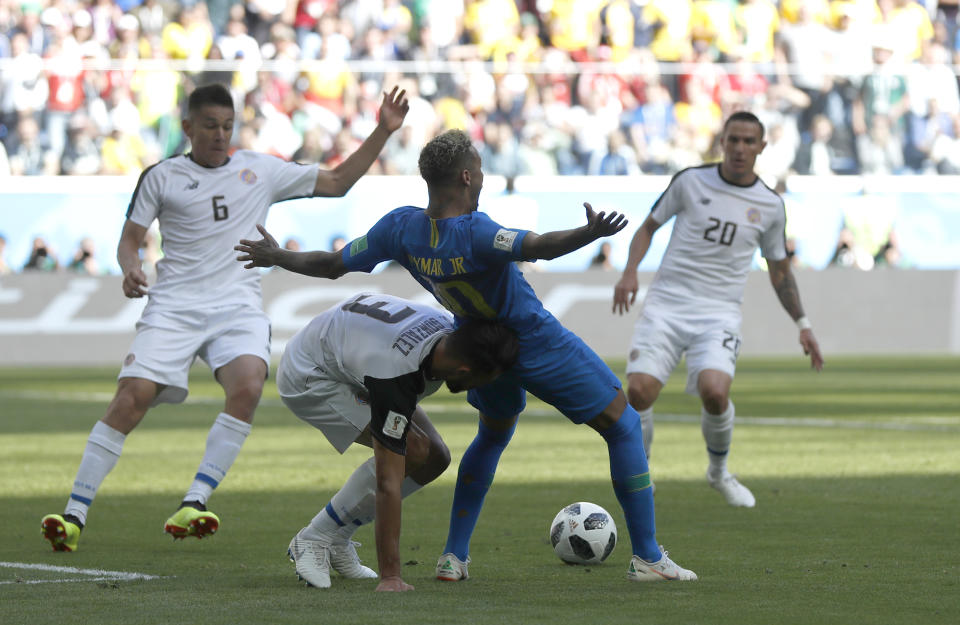World Cup: Why there is less flopping in women's soccer
If you’re a fan and follower of both the men’s World Cup and the women’s World Cup, you may have noticed at least one difference between the two, and it isn’t the excitement of the matches.
It’s the difference in flopping.
The antics on the men’s side would make LeBron James blush – diving divas who have taken theatrics to an art form. It’s either amusing or annoying, depending on your team and your tolerance. It’s certainly common. Stoppage time on the men’s side often ends up being “collapse compensation time.”
One 2011 study at Wake Forest found that men’s soccer matches average 11.26 injuries per match with only 7.2 percent of them being actual injuries. The women’s percentage of real injuries was 13.7 percent.
Beyond that, there’s less whining in the women’s game, less fake outrage at referees, less dramatics. Yet there’s just as much effort and playmaking. It’s refreshing. The players mostly just play.
The question is, why?

Jerry Smith, head coach of the Santa Clara women’s program, has taught both the men’s and women’s game. He says part of it is that boys see their heroes on the men’s side on television and pick up the bad cues as well as the good. “Generally, boys watch much more,” he says. “They see their idols much more on TV.”
Obviously girls watch both the men and the women, but when they get onto teams, the culture is more – shall we say, no-nonsense – because the greatest players have never needed to flop to excel. Mia Hamm rarely went down like a ton of bricks; she rarely lost her balance for any reason.
There might also be a national factor at play. The American men don’t flop as much as some others around the globe – or at least not as overtly.
“When I’m coaching [boys], I’m constantly trying to educate what it’s like to play a game in Germany,” Smith said. “You can’t put your hand on small of somebody’s back or they’ll go down. American players are naïve when it comes to that aspect of the game.”
The American women win World Cups and the rest of the world emulates them. They are the New England Patriots of their sport, and they have their own Patriot Way that doesn’t involve tragicomedy. So there might be reluctance among their competitors to flop and risk the chance that Becky Sauerbrunn simply takes the ball and starts a counterattack while the referee shrugs.

Here’s the question for next year’s World Cup and beyond: As the women’s game continues to become more competitive, will the culture persist? As more women’s national teams build up their programs and threaten the dominance of powers like the U.S., there will be larger TV audiences and more money. (Remember, the most-watched soccer match in American history was a women’s game – the 2015 World Cup final.) The competitive nature is already top-notch, but will another notch in the level of competition (not to mention strength and speed) lead to more pushing of the envelope on the women’s side?
“I actually think women don’t like that side of the game,” Julie Foudy told the New York Times back in 2011. “But my cynical side tells me that as women get more sophisticated and watch the game more and the stakes get higher, it will become more prevalent.”
It’s possible, but that Foudy quote came two cycles ago and not a lot has changed. It’s been a full generation since the 1999 U.S. team won the World Cup in Pasadena, and we haven’t seen much moral decay when it comes to taking dives. If you talk to youth referees today, they’ll mostly tell you there isn’t nearly as much antics or talkback from girls as from boys. (Parents? That’s a different story.)
So with some exceptions, the women’s game has caught up in most of the good ways without most of the bad baggage. Maybe next year we will see a change.
In the meantime, the men are on the world’s stage. Enjoy the show.
More World Cup on Yahoo Sports:
• Bushnell: The two sides of Toni Kroos and Germany
• Kroos’ dramatic late winner rescues Germany
• FIFA knew of Russian doping, did nothing – report
• Why Swiss goals, celebrations were both political, provocatic

